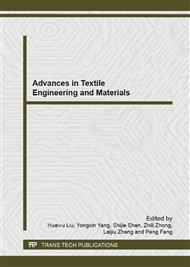p.378
p.382
p.386
p.390
p.394
p.399
p.404
p.411
p.417
Synthetic Batik Wastewater Pretreatment Progress by Using Physical Treatment
Abstract:
One of the most important manufacturing industries in Malaysia is textile and specifically batik making. Many local batik factories discharge their wastewater, which contains wax, resin, silicate and dyes, without treatment, directly to nature. A possible treatment system involving membrane filtration has been tested to remove the dyes. However the presence of wax the wastewater requires a pretreatment stage to remove the undesired wax. In this study the performance of baffle tank pretreatment (own designed and fabricated) was evaluated for 4 different types of synthetic batik wastewater, which contain wax, resin, sodium silicate and 4 different fibers reactive dyes namely, Remazol Turquoise Blue G133 (Blue 21), Remazol Red 194 and Remazol Yellow 14 and Reactive black 5. The removal efficiency (%), pH and COD of each sample were evaluated and recorded. Wax removal efficiency in all samples was more than 88%. The COD and pH of all samples decreased after 60 minutes pretreatment cycle.
Info:
Periodical:
Pages:
394-398
Citation:
Online since:
December 2012
Keywords:
Price:
Сopyright:
© 2013 Trans Tech Publications Ltd. All Rights Reserved
Share:
Citation:


